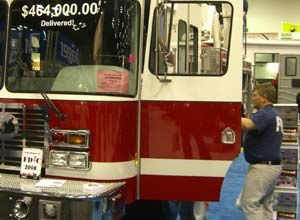
| Editor's note: In this, the third part of our series on the economic downturn and its impact on the fire service, Apparatus Budgeting Consultant John R. Hill outlines the steps departments can take in minimizing the impact on apparatus purchasing. |
Economic downturn hits fire departments
Fire service looks ahead to Obama presidency
 Photo Jamie Thompson Visitors to FDIC in March check out apparatus on display in the exhibit hall. |
For the foreseeable future, most departments will be forced into one of four tough decisions:
1. Eliminate other expenses such as payroll to make room in the budget for a new truck
Truck prices are growing much faster than budgets, meaning new apparatus will take an increasingly larger share of the budget.
2. Postpone or delay buying the new truck until the budget allows
Simply put, departments may keep existing trucks in their fleet longer. This means that while its firefighters will not have the latest, greatest and safest trucks available, staffing will not be cut.
3. Buy used trucks
Some departments may find that a quality used truck will meet their current needs at a more affordable price.
4. Get creative in raising new revenues
Departments will have to work extra hard to explain their value to the community and raise funds to meet the increased budget needs. In doing so, these departments may continue to get the new apparatus they need without major budget cuts.
Some savvy fire departments are taking some proactive steps right now to minimize the impact of the two trends we're seeing:
Planning ahead
Some departments are in a position of knowing they must replace a fire truck in the next few years. They can’t avoid it and can’t postpone the purchase; their existing truck may be becoming unsafe or too costly and difficult to repair.
Departments in this position can take some steps right now to immune themselves from future price increases. By accelerating their purchase, they may miss the 2009 NFPA and 201 EPA mandated cost increases along with the general price increases that have seriously affected fire truck pricing over the past five years.
Most manufacturers can provide a calculator to help determine the cost advantage of buying now versus buying later at an inflated price.
Some departments may be in a position of needing to buy a truck now and a truck (or trucks) in the relatively near future, too. This same concept may help them gain some price concessions and protect themselves by buying all the trucks now.
In addition, for those departments that are still paying loan payments on their last truck purchase, it may make sense to consolidate the current loan to be able to capture the lower truck prices today.
Buying right
When times are good, it can be beneficial to project an image of a large beautiful custom fire truck even if you never fill up the cab. But in tough times like these, it may make sense to buy a truck that fits how you actually use the apparatus.
Because of the current economic climate, there may be departments that will analyze their needs and decide they can have one truck built that will replace two trucks. For example, they may be able to combine a first out engine with a rescue truck. This would eliminate the need to buy two trucks – either now or in the future – and save precious budget dollars.
| Food for thought from | |
| "I truly believe we are in for a difficult 18 months to two years ahead of us as a national fire service." — Pete Lamb in Can I have more in my allowance now? | |
Other departments are even looking at sharing the purchase of specialty vehicles such as aerials or heavy rescue or command vehicles with a neighboring community. This involves the creative sharing of power and resources but can be effective in reducing the overall cost of the more expensive vehicles that see a little less action.
Finally, some departments will need to examine the benefits of used fire apparatus. While never fun, the cost savings of buying a depreciated truck can help a department manage during these tough times to upgrade the truck they need while minimizing the budget impact.
Selling your value
Fire protection has to be the closest thing to a free lunch in the United States. Thousands of communities across the country receive the benefit of fire protection for a fraction of the cost of providing it.
Proactive fire departments are starting to educate their communities about the cost of providing fire protection and the shortfall in funding this primary public safety function from public funds. The ingrained financial habits of this almost free service will be hard to overcome.
But there is a cost, especially for volunteer departments, to asking for increased funding to operate the fire department. Financial accountability and openness will be required in exchange for this funding. Many departments savor the operating freedom and lack of interference.
While the times may appear grim and the financial pressures squeezing departments from every angle, there are several steps that proactive fire departments can take to navigate through these turbulent financial times.
 |
John R. Hill is an apparatus budgeting consultant for Envizion Financial, which helps fire departments avoid common financial mistakes that are made in the apparatus purchasing process. John also writes a weekly Web site column on FireFinanceGuy.com.
Copyright © 2024 FireGrantsHelp.com. All rights reserved.